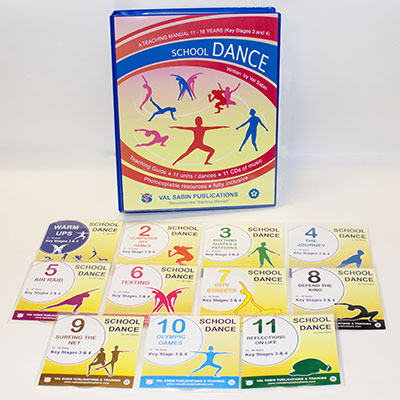Val Sabin Secondary School Dance KS3 and KS4:

- User-friendly scheme for the whole school
- Ideal for teachers of Key Stage 3 and 4 Dance
- 11 units of Dance
- 11 CDs of music
- Exceeds National Curriculum requirements
Secondary School Dance KS3 & KS4 Sample Pages
View Secondary School Dance KS3 & KS4 Sample Pages
Introduction to Secondary School Dance KS3 and KS4
The Secondary School Dance KS3 and KS4 is a complete scheme of work for the 11 units of dance and 11 CDs of music. It’s progressive and developmental materials exceeds the National Curriculum 2014 expectations. The master manual is also photocopyable (in your own school).
How do you use the scheme?
This is a most comprehensive and user-friendly manual for teachers of Key Stage 3 and Key Stage 4 dance.
The 11 units of work contain 64 “phases” of learning and development (or session plans) that progress and develop 11 dances through 108 tracks of music set out on 11 CDs. The appendix also includes 44 accompanying photocopiable cards.
The introduction to the manual gives practical and definite guidance on manual structure and material; The skills and principles which comprise the language of dance; Patterns, phases, motifs and dance structure, and creating a well balanced and choreographed dance.
There is also a complete section of the introduction devoted to warm-up and cool down, which includes 7 warm-ups to music and stretching cards.
Dances appropriate for Key Stages 3 and 4 are linked to National Curriculum requirements. Minimum expected standards are identified to aid the assessment process.
Planning
The medium term plan at the beginning of each unit of work provides the Learning Objectives, Expected Learning Outcomes and Dance frameworks which clarify planning and focus learning.
To cater for the very different teaching styles or levels of experience of teachers delivering dance, the phases of learning are presented in varying degrees of detail, so teachers can choose the one they feel most comfortable with.
This ranges from teachers following the detailed guidance as it is presented – right through to using the music and the type of movement suggested and creating their own interpretation.
There is a range of styles of music – which have been designed specifically for the dances. There are skateboard sounds, electronic sounds, rhythmical music, “big band”; ring tones, mixtures of dramatic music and sound effects, “theatre scenes”, rap music and “changing moods” music as examples.
The dances are varied in style and include examples of representative, symphonic, dramatic, lyrical, creative & artistic and dance by chance.
The dances are:
- WORDS
- COMPUTER SPY GAME
- RHYTHMS SHAPES AND PATTERNS
- THE JOURNEY
- AIR RAID
- TEXTING
- CITY STREETS
- CHESS – DEFEND THE KING
- SURFING THE NET
- THE OLYMPICS
- REFLECTIONS ON LIFE
The original music for the dance has been composed especially to fit the intention and the “story” of the dance. The music for each individual phase of the dance has been isolated and transferred to its own track for ease of practice.
Similarly, there are tracks where two phases are joined together, and indeed sometimes whole sections. This allows for the gradual build-up and continuity of the dance to take place. Each dance is accompanied by its own CD.
There is a seperate CD containing warm-up tracks of music. There are more than enough dances in this manual to construct a scheme of work for Key Stages 3 and 4.
The scheme of work identified by a school is very much the particular pathway they have chosen to follow. They will select the dances and the order in which they will deliver them and create their own unique scheme.
When selecting dances for a scheme it is important to choose a variety of topics which give pupils the opportunity to:
- explore the different types and styles and dance
- focus on developing their knowledge and understandin of composition
- develop their understanding of communicating the choreographic intention, both as performers and choreographers
- explore and communicate ideas and issues, and their own thoughts and feelings
- develop an awareness of the historical and cultural origins of different dances
The dances in this manual provide opportunities for all of these. Each dance or unit of work contains:
- a short overview of the content of the dance and its benefits and
- a list of the music tracks specific to the dance
- a “header” page which is the medium term plan detailing…
- – learning objectives
- – dance framework
- – expected learning outcomes
- a synopsis of the dance structure briefly identifying the different
- phases of the dance and the type of movement used in each phase
- the phases of learning as detailed teacher notes. The phases
- gradually build into the complete dance
- an accompanying CD of music (exept for the WORD dance which
- uses percussion)
- resources in the form of cards in the appendices and warm-up/cool
- down activities in section C
The dances are built up very logically. There is ample time and opportunity allowed for pupils to develop knowledge, skills, understanding, concentration and physical competence in each phase and fluently to link them together.
Teaching Resources
Teaching resources are included. Where appropriate there are resources such as word banks, action cards, “alphabetashapes”, check lists etc. These are all presented as photocopyable “masters” in the yellow section in the back of the manual.
In a similar way there are “masters” for a series of general warm-up and stretching cards which can be used as an aid to independent learning. These can be found in Section C at the end of the Teaching Guide.
To cater for the very different approaches, styles and requirements of teachers of dance in Key Stages 3 and 4 the phases of learning are presented in varying degrees of detail so teachers can choose the one they feel most comfortable with.
- a synopsis of the dance structure with each phase briefly described with suggestions for appropriate movement to convey the intention of the dance
- detailed teacher notes for each phase preceded by a brief description of intention. Specific suggestions on actions, dynamics, spatial possibilites and relationships complete the notes
- some dances (“words”, “computer spy games” and “texting”) contain the phases written up as detailed lesson/session plans for those who prefer specifics
The dances roughly follow an order of complexity in their presentation – with the least complex nearer the beginning of the manual and the more complex closer to the end of the manual.
BUT-REMEMBER any dance can be made more or less complex by changing the actions / dynamics / spatial features / relationships / group sizes etc. Because of this, a dance could be chosen by topic rather than by degree of complexity and changes can be made as the teacher feels necessary.
LISTEN TO THE IDEAS OF THE PUPILS – they will often change the whole focus of a dance with their combination of ideas – thus creating a unique dance.
Price
£150.00 (Hardback)
Please contact us to place your order.

